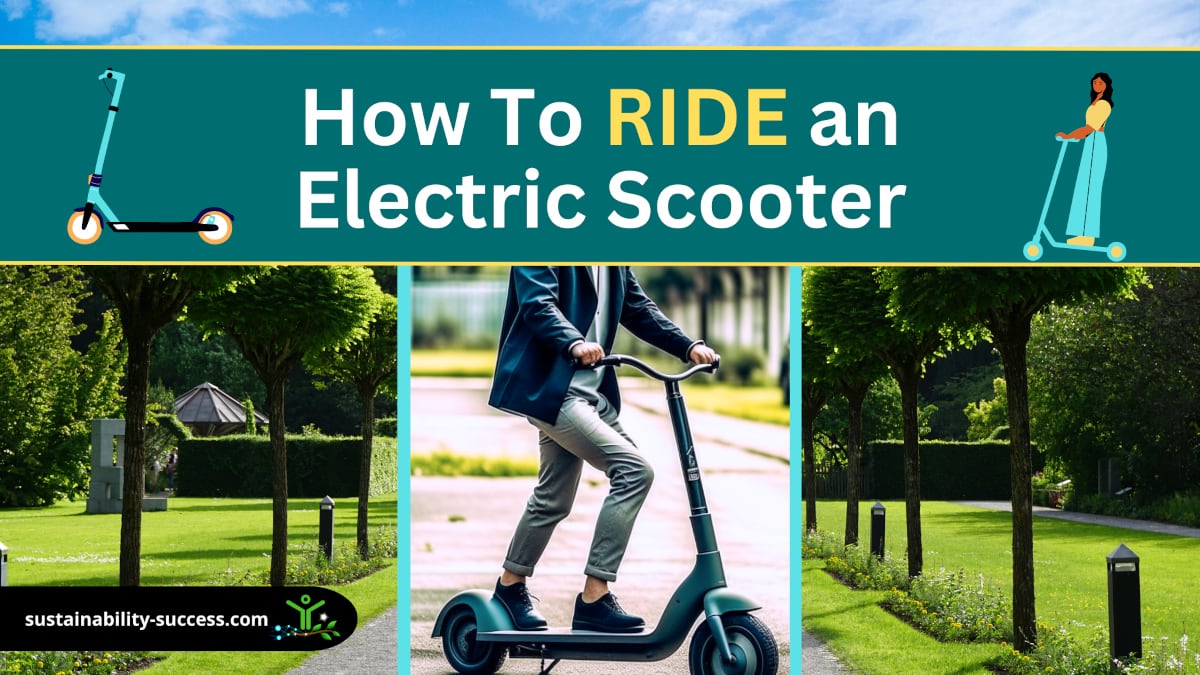Electric scooters are an incredibly fun, eco-friendly, and convenient way to get around. If you’re looking at how to ride an electric scooter for the first time, I’ve got you covered.
Key Takeaways
- Ensure safety gear is worn and scooter is in good condition.
- Start with proper positioning and initial momentum.
- Accelerate gradually and gently use brakes to slow down.
In this beginner’s guide, I’ll walk you through everything you need to know about how to ride an electric scooter safely and with total confidence. Get ready to become a pro!

checks to do Before riding an electric scooter
Before riding your electric scooter it is essential to check a few things for your safety. So, here’s a handy pre-ride checklist for you:
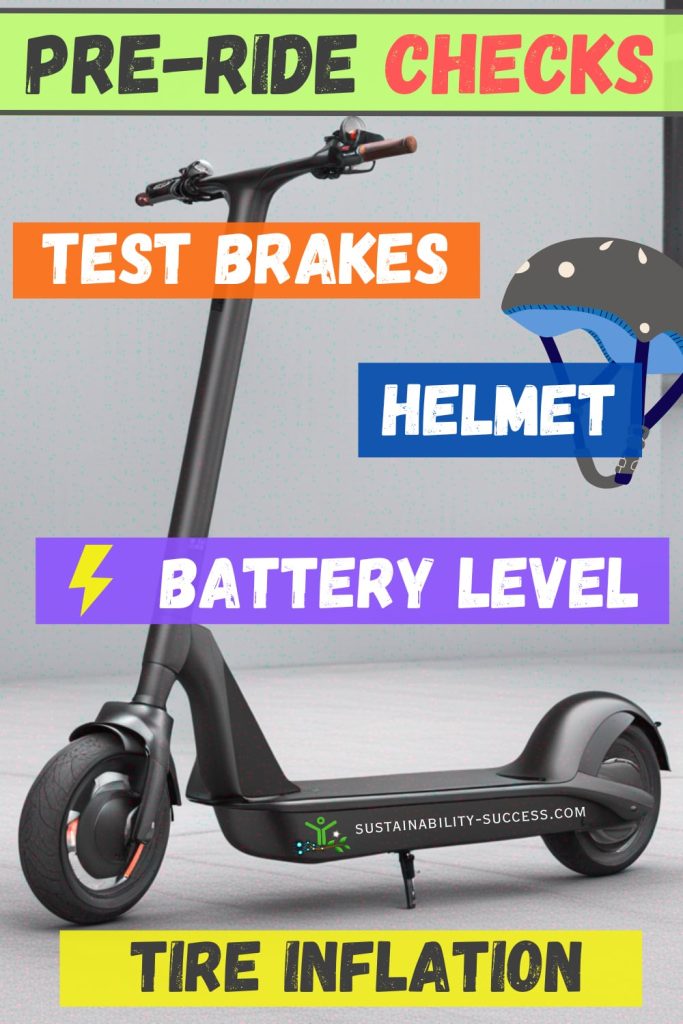
Pre-Ride Checklist
Once you’ve selected the perfect e-scooter for your needs, there are a few things you need to do before hopping on for your first ride:
1. Safety Gear
Always wear a helmet, even on short rides. Check that your helmet fits properly and fastens securely under the chin.
Also, wear appropriate footwear like closed-toe shoes with decent tread. And avoid loose clothing that could get caught in the wheels.
2. Read Instruction Manual
Carefully read through the instruction manual so you understand how to:
- Adjust the handlebar height
- Fold and unfold the scooter
- Operate the throttle
- Engage the brakes
- Charge the battery
- Change riding modes
- Turn lights on and off
3. Battery Charge
Always check the battery level before riding. Most scooters have a battery indicator display, or you may need to press a button to check the level. Make sure it’s adequately charged for the distance you intend to cover.
4. Tire Inflation
Use a bicycle tire pressure gauge to check the air pressure in both tires. Inflate them to the manufacturer’s recommended PSI if needed. Proper inflation prevents flats and enhances stability.
5. Test Brakes
Perform a brake test in a safe area without obstacles. Travel at slow speed and engage both the front and rear brakes independently to ensure they are functioning properly before riding.
6. Adjustments
Adjust the handlebar height to suit your height. You should be able to stand comfortably flat-footed while holding the handlebars. Also, check that any folding locks or latches are properly secured.
7. Local Laws
Be aware of any local regulations regarding electric scooter usage and follow all applicable regulations and traffic laws. For example here are some e-scooter regulations in New York state. Make sure to check any laws that are in place in your own state beforehand.
How to Ride an Electric Scooter
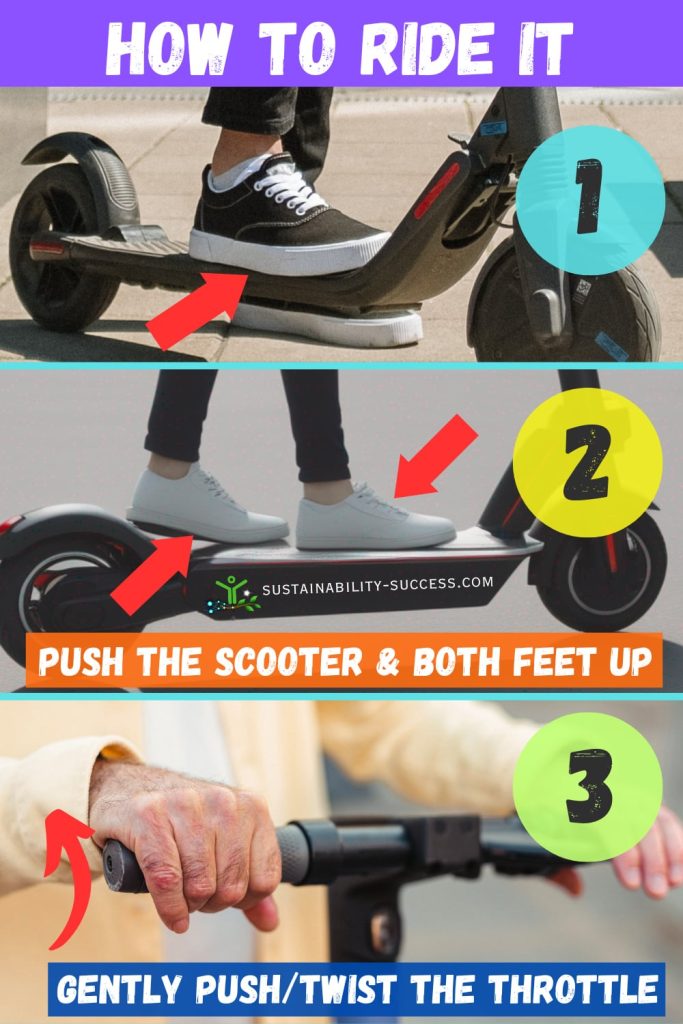
Okay, now let’s get into the specific steps on how to ride an electric scooter. I advise you to find an open area with no obstacles or traffic for your first ride. This will help you to gain confidence without risking causing some damage around you.
Here’s how to use an electric scooter! Follow these steps for a successful first e-scooter experience:
1. Position Yourself on the Standing Deck
- Place your dominant foot forward on the deck for optimal control and balance.
- Keep both knees bent and your body relaxed but upright.
- Grip handlebars firmly with elbows bent and head up.
2. Kick Off to Starting Speed
- Push your dominant foot against the ground to initiate momentum.
- Once the scooter reaches approximately 2-3 mph, the motor will engage.
- Lift your kicking foot onto the rear of the deck once powered.
3. Slowly Twist/Push the Throttle to Accelerate
- Gently push the throttle button to speed up (or twist the right handgrip throttle toward you, depending on your e-scooter model).
- Accelerate smoothly, avoiding sudden jerky movements.
- For stability, lean forward slightly as you speed up.
4. Use Hand Brakes to Slow Down
- Grip the left-handle brake lever to engage the front brake.
- Step on the rear fender brake with the foot to activate.
- Slow down gradually for maximum control.
5. Lean Your Body to Turn
- Avoid turning handlebars at speeds above 5 mph.
- Lean your body in the direction you want to turn – left to turn left, right to right.
- Look ahead toward your intended direction of travel.
- Maintain a slight bend in your knees and keep the speed steady.
6. Use Your Foot to Brake When Stopping
- Come to a controlled stop by pressing the rear fender brake (if your e-scooter has it, otherwise just brake gently) with your foot.
- For safety, rotate your shoulders and head to look behind you.
- Step off the kickstand to fully stop and park your e-scooter.
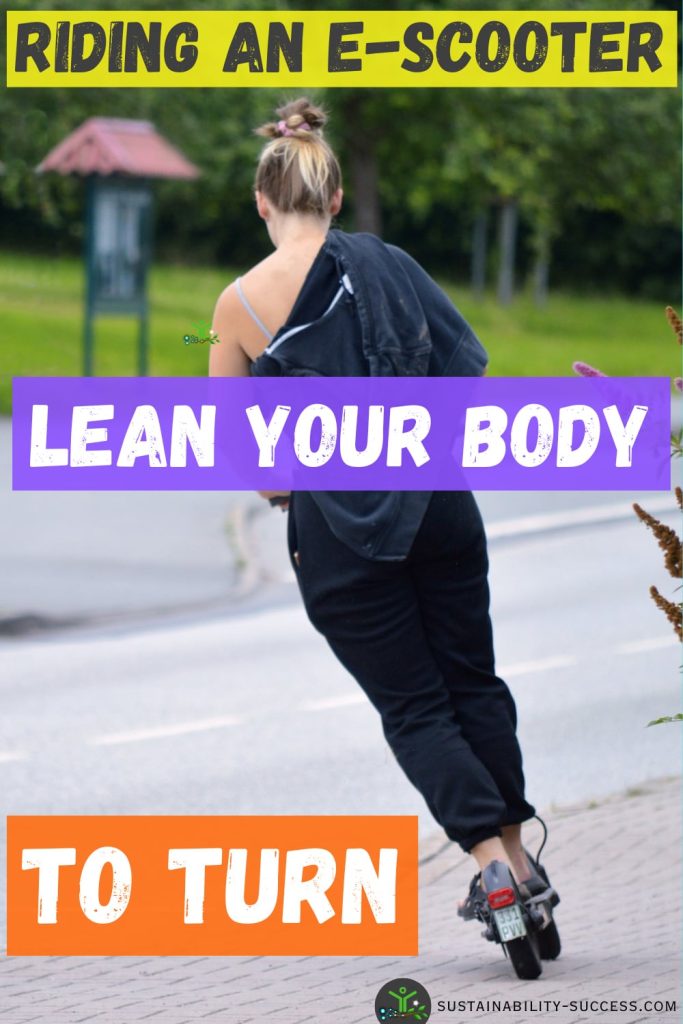
Tips for Safe E-Scooter Riding
Keep these additional tips in mind for a smooth, enjoyable, and hazard-free electric scooter riding experience:
- Always wear a helmet – protects against serious head injuries if you fall
- Wear proper footwear like sneakers – sandals or flip-flops can lead to foot injuries
- Follow all local regulations – rules about where you can ride may apply
- No headphones – need full awareness of surroundings
- Be vigilant and watch for cars, bikes, pedestrians
- Keep your speed under control – don’t ride too fast for the conditions
- Stay sober – never ride while intoxicated
- Scan your surroundings for potential obstacles like pedestrians, bicyclists, pets, or potholes.
- Keep both hands firmly on the handlebars at all times.
- Avoid using mobile phones or any other distractions while riding.
- Stay alert and don’t ride while overly tired.
- Yield to pedestrians and pass with ample clearance.
- Use a headlight and wear reflective gear to enhance visibility at night.
- Watch your speed, especially on inclined or wet surfaces.
- Avoid aggressive or reckless maneuvers like weaving through traffic.
While electric scooters provide an exciting way to get around, safety should always be your top priority.
ADVANCED E-Scooter Riding Techniques
Warning: don’t try those maneuvers if you are not yet extremely confident while handling your e-scooter.
Now you know how to drive an electric scooter. Once you’ve mastered the basics, you can move on to some more advanced electric scooter riding skills. Here are some to try after getting fully comfortable with riding:
Carving
Carving is the ability to fluidly ride in a zig-zag “S” pattern by rhythmically leaning side to side. It allows you to maintain momentum while navigating around obstacles.
- Approach at a moderate speed.
- Lean sharply into the first turn without handlebar input.
- As you complete the turn, immediately lean in the opposite direction to carve back.
- Time your weight shifts smoothly without pausing between turns.
Riding Backwards
This maneuver involves turning 180 degrees on the scooter so you ride facing the opposite direction.
- Come to a complete stop first.
- Pivot your body and handlebars to turn around.
- Lean forward over the handlebars to keep the rear wheel down.
- Twist the throttle gently and use your shoulders to steer.
Hopping Obstacles
To safely ride over bumps, cracks, or holes:
- Approach perpendicular to the obstacle if possible.
- Shift your weight back as you reach the obstacle.
- Use your arms and legs as shock absorbers during impact.
- Maintain a steady speed and look ahead.
Emergency Braking
If you need to stop immediately:
- Squeeze both brake levers while shifting weight back.
- Lower your center of gravity by bending your knees.
- Look ahead and straighten the handlebars to stop straight.
- Engage the rear foot brake just before fully stopping.
Riding Safely Around Pedestrians
Sharing pathways and sidewalks with pedestrians present unique hazards. Keep these tips in mind when riding your e-scooter around people on foot:
- Slow down and allow plenty of clearance when passing.
- Make eye contact and give audible signals like “on your left”.
- Allow pedestrians the right of way.
- Avoid startling people by suddenly zipping up behind them.
- Walk your scooter in very crowded areas.
- Be exceptionally cautious around children, the elderly, or pets.
Riding an E-Scooter at Night
Riding after dark comes with additional challenges. Here are some night riding tips to keep in mind:
- Use front and rear lights at all times.
- Wear reflective clothing and helmet stickers.
- Ride slower and increase following distances.
- Stick to well-lit streets and avoid dark alleyways.
- Scan pavement carefully for debris or obstacles.
- Make sure brakes are in optimal functioning order.
- Carry a flashlight in case of emergencies.
Electric Scooter Riding Etiquette
To safely and courteously share public spaces when riding your e-scooter, follow these rules of etiquette:
- Stay to the right and pass on the left.
- Yield to pedestrians.
- Use a bell or voice when overtaking others.
- No reckless weaving or speeding.
- Pull fully off the pathway when stopped.
- Park out of the way of foot traffic.
- Slow down and establish eye contact at intersections.
- Be predictable, cautious, and respectful.
Choosing Your Electric Scooter
Now that you know how to ride an e-scooter and the safety considerations, it’s time to pick out your ride! To help you out, here’s the best electric scooter for someone that is just starting out:
There are a few key factors to consider when selecting an electric scooter as a beginner:
Types of Electric Scooters
There are three main categories of e-scooters to choose from:
- Kick scooters – Require you to kick off the ground to get started, then the motor engages
- Self-balancing scooters – Automatically balance on two wheels, so no kicking is required
- Mopeds – Scooters with a seat and generally more powerful motor
For beginners, I recommend starting with a basic kick scooter. They’re the simplest to use and most affordable option.
Key Features to Look For
These are the most important features to look for in your first electric kick scooter:
- 250-500W motor – provides adequate power without being overwhelming
- 15-20 mph top speed – fast enough to get around while remaining stable
- At least a 10 mile range – should get you where you need to go on a charge
- Air-filled tires – more shock absorption than solid tires
- Front and rear brakes – critical for control and stopping ability
- Bright headlight and taillight – enhances visibility at night
- IP54 rating – can withstand light rain and splashes
- Suspension – if you would like a more comfortable ride (but it can push up the price)
Budget
As a beginner, plan to spend $300-$600 for a quality electric kick scooter from a reputable brand. This price range provides an optimal combination of performance, safety, and durability.
Avoid extremely cheap scooters under $200 – they often have quality and safety issues. Investing a little more upfront is worthwhile.
Electric Scooter Accessories
Certain accessories can enhance your e-scooter riding experience. Helpful add-ons include:
- Phone holder – Safely secures your device for GPS use.
- Helmet mirror – Improves rearward visibility.
- Basket – Provides handy storage for small items.
- Cup holder – Allows you to bring along a drink.
- Seat attachment – Offers the ability to ride seated.
- Phone charger – Charges your device right from the scooter.
- Lock – Deters theft when parked.
Benefits of Riding Electric Scooters
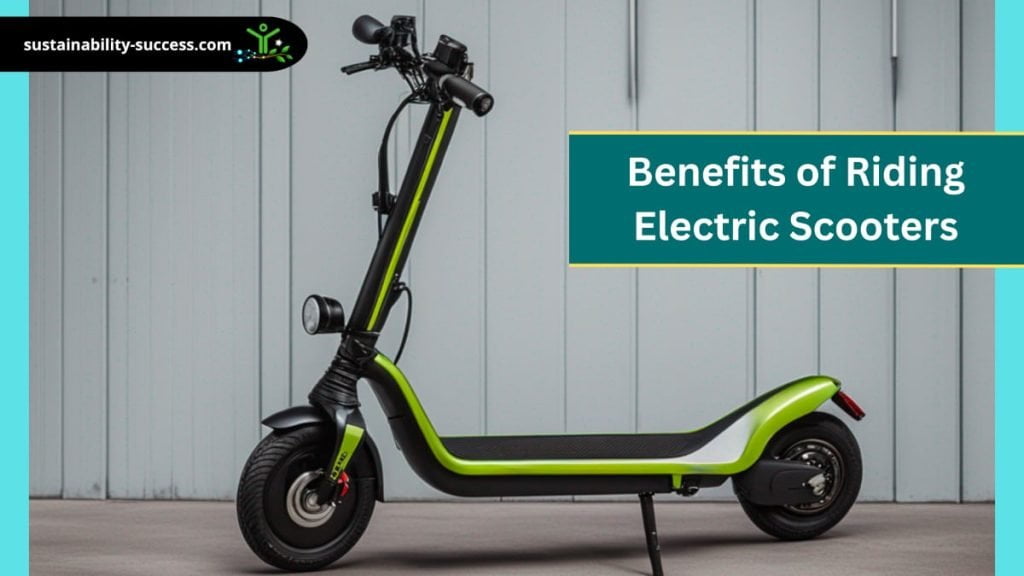
Whether you’re commuting in the city or just want a relaxing ride around the neighborhood, e-scooters provide an efficient and environmentally conscious transportation option.
Now that you know how to ride an electric scooter, let’s go over some of the main benefits that make e-scooters such a great transportation choice:
- They’re very easy to learn – most people can get the hang of riding an e-scooter within a few minutes.
- Extremely convenient and portable – they’re lightweight and foldable for carrying and storing.
- Eco-friendly – e-scooters produce zero emissions and are more environmentally sustainable compared to other forms of transport.
- Allow you to avoid traffic – easily zip through congested city streets.
- Affordable to purchase and operate – no gas or insurance costs.
- Provide a fun way to explore your city.
E-Scooter Maintenance Tips
Properly maintaining your electric scooter will keep it operating safely and efficiently. Follow this routine maintenance checklist:
- Inspect tires weekly and inflate to recommended PSI
- Check brakes and confirm proper functioning
- Ensure all screws, bolts, and fasteners are tightened
- Check for any loose parts or damage
- Keep the battery charged; don’t let sit uncharged for prolonged periods
- Wipe down with a damp cloth after wet rides
- Store indoors or covered to protect from the elements
Common Electric Scooter Problems
Despite their overall simplicity, electric scooters can still experience some problems. Here are the most common issues and how to address them:
Not Accelerating
If the scooter won’t accelerate when you twist the throttle, possible causes include:
- Dead battery – Fully recharge the battery
- Faulty accelerator or loose connection – Inspect wiring
- Motor issue – Check motor functionality
- Brake engaged – Disengage brake
- Power button not switched on – Turn scooter on
Lack of Power
If the scooter seems underpowered, it could be caused by:
- Under-inflated tires – Inflate tires to recommended PSI
- Low battery – Fully recharge battery
- Driving uphill – Steeper hills sap power
- Excess weight – Reduce loaded weight if possible
- Dirty air filter – Clean the air filter so the motor can breathe
Jerky Acceleration
Sudden jerky takeoffs point to a few possible issues:
- Motor problem – Have the motor inspected by a technician
- Speed controller issue – May require controller replacement
- Loose throttle – Check throttle is firmly connected
Pulling to One Side
A scooter that pulls left or right during acceleration could have:
- Alignment problem – Adjust handlebar alignment
- Tire pressure imbalance – Inflate tires evenly
- Worn tire tread – Replace damaged tires
- Bent fork – Carefully straighten the fork if possible
Conclusion
There you have it! Everything you need to know to start riding your e-scooter like a boss! With practice, these techniques will become natural.
I hope this guide provided you with all the information you need to start riding an electric scooter safely and confidently. While mastering some techniques will take practice, the basics of e-scooter riding are relatively simple to pick up.
Focus on protective gear, learning your scooter’s features, and following basic operational steps. And most importantly, have fun with your new set of eco-friendly wheels!
You may also be interested in reading:

